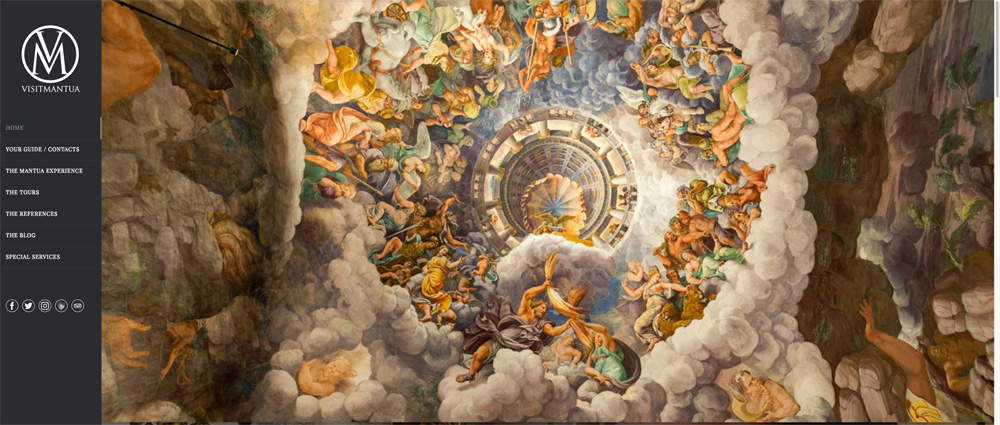Facebook has become the protagonist of yet another art blackout: the victims this time were the Bridal Chamber of the Castle of San Giorgio and the Chamber of the Giants of Palazzo Te in Mantua, blocked by Mark Zuckerberg’s social network because of the presence of nude cherubs in the oculus of the Bridal Chamber painted by Andrea Mantegna, the great artist active in the Renaissance at the Gonzaga court, and nudes in Giulio Romano’s frescoes in Palazzo Te. As far as we know and remember, this is the first time the Facebook axe has come down on a property recognized as a UNESCO World Heritage Site.
The facts date back to December, and the protagonist of the incredible mishap is Lorenzo Bonoldi, an art historian who is an expert on issues related to the Mantuan Renaissance and its great protagonist Isabella d’Este, as well as a tour guide. The scholar intended to promote his services as a tour guide through an advertisement on Facebook that could link to the website of his business, VISITMANTUA. VISITMANTUA’s website, however, included images of the oculus of the Bridal Chamber and Giulio Romano’s frescoes, which were judged to be adverse to Facebook’s policies: probably, Lorenzo Bonoldi jokes, the social understood the initials VM in Visit Mantua’s logo as “Forbidden to Minors.” We respect, of course, the decisions made by Facebook staff, but we wonder if these constant blackouts against art cannot be reviewed and if Menlo Park’s social could not grant an exemption on nudity at least for works of art. Especially if they are works of clear fame and if they are absolute cornerstones of world art history: we strongly reiterate that art should know no censorship and we ask Facebook to reconsider its rules and allow the publication of images of works of art to those who live precisely thanks to art. Lorenzo Bonoldi has told us in detail what happened, and we submit this story to the attention of our readers because we intend to raise awareness of an issue that we believe is of fundamental importance in the field of artistic communication, and therefore as important for insiders as it is for the public that every day accesses via social media content that concerns art in all its forms.
 |
FSA. Dr. Bonoldi, can you briefly summarize your Facebook misadventure and where it came from?
LB. Last November I embarked on an ambitious venture: to create a Gingerbread version of St. George’s Castle. My intent was to use my creation to advertise my tours in Mantua during the Christmas season. After spending whole days kneading, baking, frosting, and assembling, I believe I achieved a good result. I then proceeded to photograph my creation by building a small stage in the house, placing the castle among miniature pine trees, small deer and artificial snow: when the work was done, I had finally achieved the result I had set out to achieve. The Christmas image of the castle of San Giorgio, accompanied by the slogan: “Visit Mantua: a real winter wonderland,” was printed on flyers, postcards and greeting cards and placed on the homepage of my website. In the wake of its success, I then decided to do a sponsored campaign on Facebook and Instagram as well, and here the real story begins.
 |
| The reproduction of the Castle of San Giorgio di Mantova in gingerbread made by Lorenzo Bonoldi |
What happened next?
After I submitted the campaign to Facebook I received a message, informing me that the campaign had not been approved. Completely innocently I thought there had been a mistake. I then came to the conclusion that a fictitious “nudity detector” (I suppose if our phones recognize faces, it is possible that there are programs that recognize other anatomical parts) had gotten the wrong end of the stick, mistaking the castle image for a nude image. Perhaps the color of the gingerbread could have recalled the color of a human being’s skin? I then sent a message to Facebook’s Ads Team specifying that (and I quote literally) “this ad does not contain any nude images. It is about a gingerbread castle.” This clarification from me was followed by a response from the Facebook Team informing me that the problem was not with the castle image. I quote again verbatim, “It appears that the landing page URL you included in the ad does not comply with Facebook’s Ad Guidelines. We do not allow ads that contain nude images, even if they are not sexual in nature. This includes the use of nude images for artistic or educational purposes.” And for the avoidance of doubt, I was being sent screenshots from my site showing the ceiling of the Bridal Chamber frescoed by Andrea Mantegna and the vault of Giulio Romano’s Camera dei Giganti.
 |
| The oculus of the Bridal Chamber in the VISITMANTUA website |
 |
| The Chamber of the Giants at Palazzo Te in the VISITMANTUA website. |
So Facebook effectively obscured paintings of paramount importance to art history, reproduced in all manuals as foundational masterpieces of Western art. How did the affair proceed?
Once I realized that the problem was the presence of the link to the VISITMANTUA site, I reluctantly decided to change the text of the paid advertisement, removing the direct link to the site. But that clearly was not enough: even after removing the link, the Facebook Team was not approving my advertisement. So I asked for clarification, and this time the message exchange was in English: “Hello and thank you for helping me with this. Now: in this very AD there are no nudes, and this AD does not include a link to my website any longer. Working as a tour guide, of course my website contains images of Renaissance works of art in which naked bodies are exposed. And by the way, those frescoes have been declared to be UNESCO treasures. Are you telling me that every AD of my activity will be not accepted by Facebook because I have images of Renaissance works of art on my website?” I received this response from Griffith, a member of the Ads Team: “Hi Lorenzo, Your Facebook and main webpage are always considered components of your ads, regardless of whether or not you include the links. As long as there is nudity on your page, even of an artistic nature, your ads may be rejected. I apologize for the inconvenience.” The situation was now clear: as long as there are Mantegna’s nude putti on the VISITMANTUA website or Giulio Romano’s veil-less deities, Facebook, and by extension Instagram, will deny me the ability to do paid ads.
How did you feel about not being able to run ads because of the presence of nudes in the works of Mantegna and Giulio Romano?
The networks are their property and it is right that they set the rules. I will advertise elsewhere. The curious thing is that despite the “ban,” I receive weekly emails from the Facebook Team in which I am advised that my content is “high performing” and could reach more users with a paid ad. Too bad I can’t take advantage of that...after all, the letters VM appear in the VISITMANTUA logo: Forbidden to Minors.
Warning: the translation into English of the original Italian article was created using automatic tools. We undertake to review all articles, but we do not guarantee the total absence of inaccuracies in the translation due to the program. You can find the original by clicking on the ITA button. If you find any mistake,please contact us.